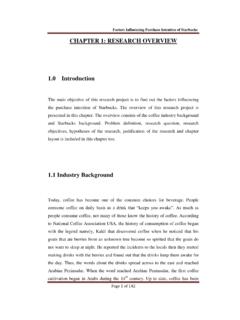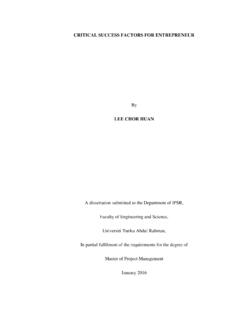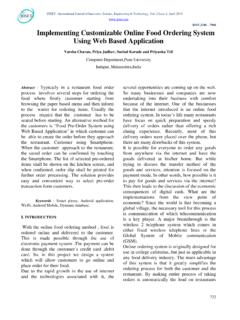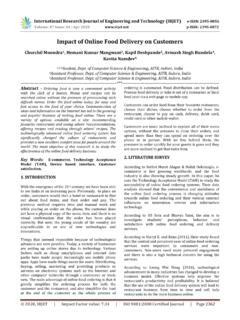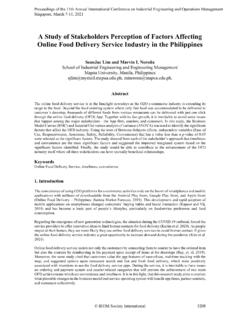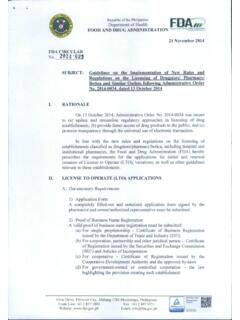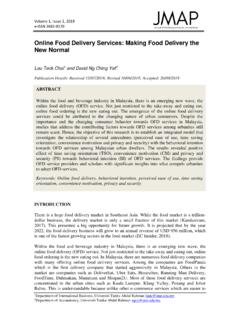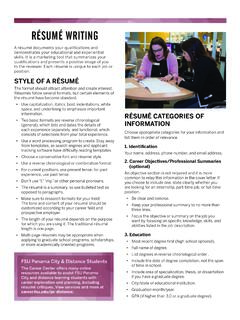Transcription of RESTAURANT ORDERING SYSTEM
1 RESTAURANT ORDERING SYSTEM By Wong Siew Jiuan A REPORT SUBMITTED TO Universiti Tunku Abdul Rahman in partial fulfillment of the requirements for the degree of BACHELOR OF INFORMATION SYSTEMS (HONS) INFORMATION SYSTEMS ENGINEERING Faculty of Information and Communication Technology (Kampar Campus) JAN 2019 UNIVERSITI TUNKU ABDUL RAHMAN REPORT STATUS DECLARATION FORM Title: _____ _____ _____ Academic Session: _____ I _____ (CAPITAL LETTER) declare that I allow this Final Year Project Report to be kept in Universiti Tunku Abdul Rahman Library subject to the regulations as follows: 1. The dissertation is a property of the Library. 2. The Library is allowed to make copies of this dissertation for academic purposes. Verified by, _____ _____ (Author s signature) (Supervisor s signature) Address: _____ _____ _____ _____ Supervisor s name Date: _____ Date: _____ RESTAURANT ORDERING SYSTEM By Wong Siew Jiuan A REPORT SUBMITTED TO Universiti Tunku Abdul Rahman in partial fulfillment of the requirements for the degree of BACHELOR OF INFORMATION SYSTEMS (HONS) INFORMATION SYSTEMS ENGINEERING Faculty of Information and Communication Technology (Kampar Campus) JAN 2019 BIS (Hons) Information Systems Engineering Faculty of Information and Communication Technology (Kampar Campus), UTAR.
2 Iii DECLARATION OF ORIGINALITY I declare that this report entitled RESTAURANT ORDERING SYSTEM is my own work except as cited in the references. The report has not been accepted for any degree and is not being submitted concurrently in candidature for any degree or other award. Signature : _____ Name : _____ Date : _____ BIS (Hons) Information Systems Engineering Faculty of Information and Communication Technology (Kampar Campus), UTAR. iv ACKNOWLEDGEMENT I would like to express my sincere thanks and appreciation to my supervisor, Mr Tey Chee Chieh who has given me this bright opportunity to engage in RESTAURANT ORDERING SYSTEM project. A million thanks to you. I also would like to thanks my friends for their support and encouragement. Finally, I must say thanks to my parents and my family for their love, support and continuous encouragement throughout the course.
3 BIS (Hons) Information Systems Engineering Faculty of Information and Communication Technology (Kampar Campus), UTAR. v ABSTRACT This RESTAURANT ORDERING SYSTEM project is developed to transform the old and traditional SYSTEM that mostly used by the restaurants to a new and more efficient ORDERING SYSTEM . The traditional ORDERING SYSTEM brings inconvenience to both staffs and customers as it requires a lot of manual work. The manual work done by the staffs will cause some human errors such as give the incorrect bill to the customers, ugly handwriting of the waiter, incorrect sequence of the order. All these human errors will cause the customer dissatisfaction towards the RESTAURANT . Therefore, this RESTAURANT ORDERING SYSTEM is designed and developed to help the RESTAURANT to have a better management. By having this ORDERING SYSTEM , the time of placing order has reduced.
4 The customers do not need to wait to be served when they eat in the RESTAURANT . The customers will be more satisfy at this ORDERING SYSTEM . The methodology that used to develop this SYSTEM is throwaway prototyping methodology. This methodology is chosen because the SYSTEM will be developed in a shirt time compare to other methodologies. Throwaway prototyping methodology also allows the developer to listen to the feedback of the end user to keep on working on the development to match the requirements of the end user. Table of Contents BIS (Hons) Information Systems Engineering Faculty of Information and Communication Technology (Kampar Campus), UTAR. vi TABLE OF CONTENTS REPORT STATUS DECLARATION FORM i TITLE PAGE ii DECLARATION OF ORIGINALITY iii ACKNOWLEDGEMENT iv ABSTRACT v TABLE OF CONTENTS vi LIST OF FIGURES viii LIST OF TABLES x CHAPTER 1 INTRODUCTION 1 Problem Statement 1 Background and Motivation 2 Objectives 3 Proposed Approach/Study 4 Highlight of What Have Been Achieved 5 Report of Organization 5 CHAPTER 2 LITERATURE REVIEW 6 Wireless food ORDERING SYSTEM 6 Point of Sale SYSTEM 8 online ORDERING SYSTEM 9 Comparison Between Similar Systems 11 CHAPTER 3 SYSTEM DESIGN 12 Block Diagram 12 Table of Contents BIS (Hons) Information Systems Engineering Faculty of Information and Communication Technology (Kampar Campus), UTAR.
5 Vii Use Case Diagram 13 Activity Diagram 15 Place Order 15 Change Order Status of Customers 16 Update Menu 17 Update Category 18 Delete Menu 19 Delete Category 20 Create Menu 21 Create Category 22 User Interface Design 23 CHAPTER 4 METHODOLOGY AND TOOLS 31 Methodology 31 Tools 32 Requirement 32 Timeline 33 Implementation and Testing 34 CHAPTER 5 CONCLUSION 37 Conclusion 37 Project Discussion 37 Future Work 38 BIBLIOGRAPHY 39 List of Figures BIS (Hons) Information Systems Engineering Faculty of Information and Communication Technology (Kampar Campus), UTAR. viii LIST OF FIGURES Figure Number Title Page Figure 1-1 SYSTEM Flowchart of RESTAURANT ORDERING SYSTEM 4 Figure 2-1 Mobile Applications: Architecture, Design and Development.
6 6 Figure 2-2 Logical Wireless Diagram. 7 Figure 2-3 POS Architecture Diagram. 8 Figure 2-4 online ORDERING SYSTEM Context Diagram. 10 Figure 3-1 Block Diagram 12 Figure 3-2 Use Case Diagram of RESTAURANT ORDERING SYSTEM 13 Figure 3-3 Activity Diagram for Customers to Place Order 15 Figure 3-4 Activity Diagram for Staff and Chef to Change Order Status of Customers 16 Figure 3-5 Activity Diagram for Staff to Update Menu 17 Figure 3-6 Activity Diagram for Staff to Update Category 18 Figure 3-7 Activity Diagram for Staff to Delete Menu 19 Figure 3-8 Activity Diagram for Staff to Delete Category 20 Figure 3-9 Activity Diagram for Staff to Create Menu 21 Figure 3-10 Activity Diagram for Staff to Create Category 22 Figure 3-11 Home Page 23 Figure 3-12 Menu Page 23 Figure 3-13 Order Page Part 1 24 Figure 3-14 Order Page Part 2 24 Figure 3-15 Admin Login Page 25 Figure 3-16 Sales Page Part 1 25 Figure 3-17 Sales Page Part 2 26 Figure 3-18 Products Page 26
7 Figure 3-19 Update Menu 27 Figure 3-20 Delete Menu 27 Figure 3-21 Add Menu 28 Figure 3-22 Category Page 28 List of Figures BIS (Hons) Information Systems Engineering Faculty of Information and Communication Technology (Kampar Campus), UTAR. ix Figure 3-23 Update Category 29 Figure 3-24 Delete Category 29 Figure 3-25 Add Category 30 Figure 3-26 Chef Home Page 30 Figure 4-1 Diagram of Throwaway Prototyping model 31 Figure 4-2 Timeline for Project 1 33 Figure 4-3 Timeline for Project 2 33 Figure 4-4 Timeline for Project 2 (cont) 33 List of Tables BIS (Hons) Information Systems Engineering Faculty of Information and Communication Technology (Kampar Campus), UTAR. x LIST OF TABLES Table Number Title Page Table 2-1 Comparison between existing systems with proposed SYSTEM 11 Chapter 1 Introduction BIS (Hons) Information Systems Engineering Faculty of Information and Communication Technology (Kampar Campus), UTAR.
8 1 Chapter 1 Introduction Problem Statement Nowadays, many RESTAURANT using traditional RESTAURANT ORDERING SYSTEM to serve customers. In the traditional RESTAURANT ORDERING SYSTEM , the staff write down the foods that the customer order. The paper will then pass to the kitchen and the chef will start to cook. This has caused few inconveniences. The staff might make some errors while writing down the order. Sometimes, when the staff write in hurry will make the handwriting difficult to understand. The staff might lose the order paper and customers might also receive incorrect bill. One of the problem that faced by restaurants that using traditional ORDERING SYSTEM is the customers do not know the time for preparation for the food . Some of the customers might have next schedule after their lunch or dinner.
9 They need to know the time preparation so that they can plan their schedule wisely. Especially when there is a lot of customers, the customers might think their order has been forgotten if their food still not yet be served in a long time. It will be good if there is an estimated time to prepare the food shown to the customers. Furthermore, some of the customers might want to change their food or cancel their food . The customers are only allowed to cancel their order if the chef not yet start cooking. If using the traditional RESTAURANT ORDERING SYSTEM , the customers need to inform the staff, then the staff only inform to the chef. If there is a lot customer in the restaurants, the staff might forget to inform to the chef. The staff might also too late approach the chef and the customers are unable to cancel their order.
10 This problem should be solved because it is inconvenient for the customers. It is much more convenient for customers if they can cancel their order themselves. They no need wait the staff to serve them and waste the time. A cancel button should be displayed so that the customers can cancel their order if the chef not yet start cooking. Moreover, it is difficult to update the latest information to the customers. The availability of the dishes is according to the ingredients that bought every day. When there is lack of ingredients, the chef is unable to prepare some of the dishes. Therefore, it is difficult to inform every customer when they want to order. The staff might forget to inform the customers. As they have many things to do. If the customers already order and feel excited to taste the dishes, but the staff inform them the dishes is unable to order due to lack of ingredients.




